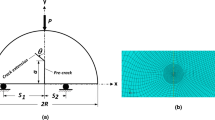Abstract
Panels of PMMA having edge cracks at an angle to applied load were tested in tension and bending. Direction of initial crack growth and load to failure were recorded. Stress analysis of each test configuration was performed, and the maximum hoop stress and minimum strain energy density criteria were used to predict failure data. Reasonable correlation between experiment and theory was realised, but with little basis for discriminating between the two failure criteria.
Résumé
On a essayé en traction et flexion des panneaux de PMMA comportant des fissures de bord faisant un certain angle avec la direction des charges appliquées. On a enregistré la direction de la propagation initiale de la fissure et la charge de rupture. On a effectué une analyse des contraintes pour chacune des configurations envisagées lors des essais, et l'on a utilisé les critères de contrainte maximum de calcul et de densité minimum d'énergie pour prédire les conditions de rupture.
Une corrélation raisonnable a été obtenue entre l'expérience et la théorie, sans pour autant offrir une base suffisante de discrimination entre les deux critères de rupture.
Similar content being viewed by others
References
J. J. Benbow and F. C. Roesler, Proc. Phys. Soc., 70B (1957) 201.
F. Erdogan and G. C. Sih, J. Basic Engng., 85D (1963) 519–525.
J. L. Swedlow, Int. J. Fract. Mech., 1 (1965) 210–216.
B. Cotterell, Int. J. Fract. Mech., 1 (1965) 96–103.
B. Cotterell, Int. J. Fract. Mech., 2 (1966) 526–533.
M. L. Williams, J. Appl. Mech., 24 (1957) 109–114.
J. G. Williams and P. D. Ewing, Int. J. Fract. Mech., 8 (1972) 441–446.
I. Finnie and A. Saith, Int. J. Fract., 9 (1973) 484–486.
P. D. Ewing and J. G. Williams, Int. J. Fract., 10 (1974) 135.
G. C. Sih and M. E. Kipp, Int. J. Fract., 10 (1974) 261–265.
J. G. Williams and P. D. Ewing, Int. J. Fract., 10 (1974) 265.
G. C. Sih (Editor), Methods of Analysis and Solutions of Crack Problems, Mechanics of Fracture Vol. 1, Noordhoff International Publishing, Leyden (1973).
G. C. Sih, Int. J. Fract., 10 (1974) 305–321. See also: Proceedings, ‘Prospects of Fracture Mechanics,‘, (G. C. Sih, H. C. Van Elst, and D. Broek (editors)), Noordhoff International Publishing, Leyden (1974) 85–102.
J. R. Rice, J. Appl. Mech., 35 (1968) 379–386.
Author information
Authors and Affiliations
Rights and permissions
About this article
Cite this article
Ewing, P.D., Swedlow, J.L. & Williams, J.G. Further results on the angled crack problem. Int J Fract 12, 85–93 (1976). https://doi.org/10.1007/BF00036011
Received:
Revised:
Issue Date:
DOI: https://doi.org/10.1007/BF00036011




